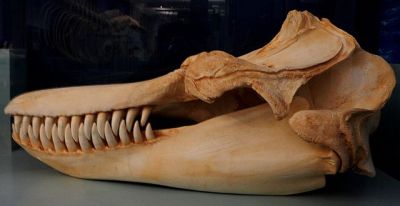Gnathostomata
 |
Orcinus orca, skull, photo by BS Thurner Hof, Museum Koenig, Bonn, showing the equipment that made the vertebrates such a successful force in the evolution of complex life on Earth . Wikipedia
The development of jaws among vertebrates, as a more efficient means of processing food, sometime during the late Ordovician period, represents one of the great success stories of animal evolution. It enabled the vertebrates to progress from being mere mud-grubbers and suction feeders to powerful preditors and efficient herbivores. Proto-jaws, in the form of tooth-like grasping structures, had already been developed by conodonts, a succesful Palaeozoic planktonic group of proto-vertebrates. But it was the evolution of powerful biting paired structures, along with the opportunities for almost unlimited physical growth that the support of a rigid yet flexible endoskeleton provides, enabled the vertebrates to dominate the sea, the land, and even the air. By the middle of the Devonian period, superpreditors such as anomolocariids, straight-shelled cephalopods, and eurypterids, that had dominated the oceans up until then, had been surpassed, and were soon to be totally dwarfed by the larger of the vertebrates. For more technical details, see Gnathostomata @ Palaeos, Philippe Janvier's Gnathostomata page, and for the evo-devo side of things, The Evolution of Jaws - Genetics and Molecular Evolution . MAK111028
new page MAK111024


